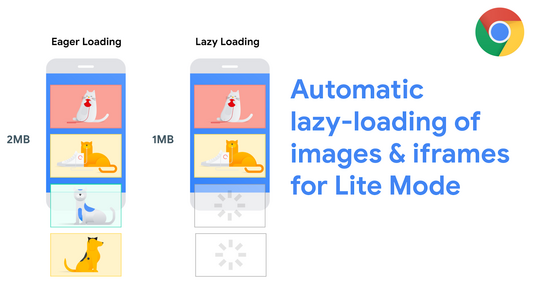Lazy loading images: how the loading attribute works?
Wed, April 16, 2025 - 2 min read

💤 Lazy loading images: how the loading attribute works
Lazy loading (loading="lazy") is a way to load an image only when it’s actually needed by the user — for example, when they’ve scrolled to it on the page.
Here’s what it gives you:
- 🏃♂️ Faster page load times — the browser doesn’t load everything at once.
- 📉 Reduced initial page weight — especially on media-heavy pages.
- 📈 Improved Core Web Vitals (LCP, FCP) — critical for SEO and Google ranking.
- 📱 Saves mobile user traffic — unused images don’t waste bandwidth.
- 🔧 Reduces load on servers and CDNs — since unused images may not be loaded at all.
Previously, to load an image only when needed, we had to:
- Include heavy libraries,
- Write hacks using
IntersectionObserver, - Mess with
requestIdleCallback,setTimeout, scroll events, - Test across different browsers — custom solutions didn’t always behave the same,
- Write polyfills or fallbacks for legacy support.
It was painful.
But now — it’s different.
🚀 HTML does lazy loading natively
With the loading attribute, the browser decides on its own when to load an image or iframe.
<img src="pokemon.png" loading="lazy" alt="pokemon pikachu" />💡 Works out of the box. Supported in most modern browsers.
📖 Support: caniuse.com/loading-lazy
🧩 The two loading values
| Value | What it does | When to use |
|---|---|---|
eager | Loads the image immediately (default) | For above-the-fold content |
lazy | Loads only when the element enters the viewport | For everything below the first view |
🖼 Example with <picture>
Yes, it works inside the <picture> tag:
<picture>
<source media="(min-width: 768px)" srcset="test.jpg 1x, larger.jpg 2x" />
<img src="pokemon.jpg" loading="lazy" alt="pokemon pikachu" />
</picture>📺 Works with <iframe> too
<iframe
src="https://www.youtube.com/watch?v=-R_3t7sHZVA"
loading="lazy"
width="630"
height="420"
title="Pokemon video"
/>🧠 When to use loading="lazy"
- Image galleries or product catalogs
- Blogs and long-form content with media
- Preview cards and content blocks
- Embedded videos or maps below the fold
📌 Summary
The loading attribute is a simple way to:
- 🚀 Speed up your site,
- 📉 Reduce unnecessary requests,
- 🤖 Get native behavior with no JS or hacks.
Enable it. Use it. And let your pages load not only beautifully — but fast.